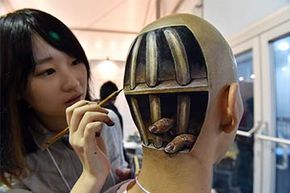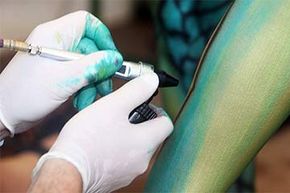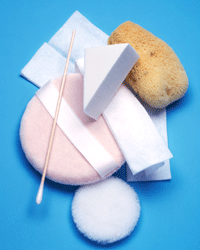The spotted creature silently weaves its way in and around the partygoers, its tail bobbing ever so slightly. Flecks of gold are sprinkled across its latte-colored skin, creating a shimmery effect when the light hits it just so. That is the most amazing cheetah costume, you think to yourself. And then suddenly the creature is at your side, and you realize it's not a costume. Not really. It's a person whose body has been transformed into that of a cheetah with paint.
Body painting has been around since the beginning of time. Men wiped streaks of paint across their cheeks to prepare for war; women placed dots on their foreheads to indicate they were married; intricate henna designs were painted onto young women's slender hands for decorative purposes. In many cultures, body painting for women morphed into the current practice of slathering on facial cosmetics. For men, it simply disappeared, save for some indigenous peoples in Australia, New Zealand, India, Africa, Japan and the Pacific Islands [sources: Bella Volen, The Pitt Rivers Museum].
Advertisement
Although traditional body painting practices may no longer be in vogue in most of the world, the practice still lives on. It's just been a bit modified. Today we paint our bodies as a form of artistic expression. And just for plain old fun. There are two main types of body painting done today. Face painting and full-body (aka large-scale) painting. The paint applied is temporary and lasts a few hours or a day. Designs can be simple or complex, with more streamlined designs typically reserved for the face, and more complex paintings for the entire body [source: Design Your Way].
Wondering what it would be like to be a body painter or a body paintee? Read on to see if you've got what it takes.
Advertisement



